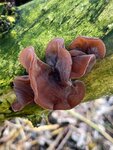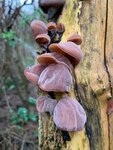


Even in the winter one can find this squiggly gelatinous edible mushroom busily decaying hardwood sticks and twigs in the forest. The aptly named Wood Ear mushroom actually goes by a slew of other common names such as Tree Ear, Jelly Ear, Little Ear, Judas’ Ear, Cloud Ear and Brown Ear Fungus. But its real scientific name is Auricularia auricula-judae.
It is a common ingredient in Chinese cuisine, such as Won Ton or Hot and Sour Soup as well as many other dishes. The Wood Ear is very versatile for cooking and capable of absorbing the flavors of broths and spices quite easily. It has a nice chewy texture, is neutral in flavor, dries easily, and is quick to reconstitute and cook with. Plus, the best thing might be that it is nearly impossible to confuse with anything that is not edible that you could find in the woods. You don’t have to go to China to find them because they grow quite ubiquitously in our woodlands and are available in many supermarkets.
Wood Ear is a kind of jelly fungus included in a group of similar genera Auriculariales, Tremellales and Dacrymycetales which includes other unique looking squishy things like the bright yellow Witch’s Butter. The Wood Ear can be disc-shaped or ear-shaped or simply an irregular blob of squishy brown to reddish-brown rubbery, gelatinous stuff.
Wood Ears have been used medicinally for centuries for all sorts of ailments such as a cure for hemorrhoids, strengthening the immune system, angina, diarrhea and even as preventing GI upset. A curious piece of medicinal history is that it was used as part of the “Doctrine of Signatures’” from the 1800s, where they very simplistically believed that if a plant or fungus resembled a part of the body, it could be used to treat ailments on that part of the body also. Since Wood Ear resembled the insides of one’s throat, they would boil it in beer, milk or
vinegar and use it to treat throat ailments.
More recently, the Wood Ear mushroom has been shown to hinder blood clotting and, if used regularly in small amounts, may help prevent strokes or heart attacks. Those are big claims however, and like all considerations of fungi for use as “mycomedicines,” I suggest the individual do their own experimenting to determine what it might actually work for you specifically and then try to learn what dosage is appropriate for your body. Unfortunately, there are not enough mycomedicine or herbal medicine research dollars floating about, so each individual needs to learn for themselves what works, and what might not work. In the meantime, do consider using Wood Ears in
dishes you may prepare. It’s kind of fun to use and since it concentrates flavors in any dish, it can produce good culinary results.
Gary Gilbert is a member of the Executive Committee of the Boston Mycological Club, lectures and leads identification walks and is the author of “Mycocards”, flashcards for learning mushroom identification (mycocards.com). He lives in Manchester-by-the-Sea.